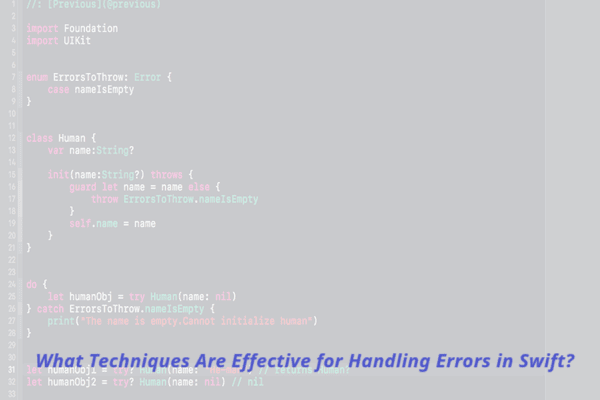What Techniques Are Effective for Handling Errors in Swift?

Swift, the language designed by Apple for developing applications, offers complete frameworks for error handling that are easy to reason about and employ. The first reason for proper error handling is to ensure that the application is virtually free of fatal errors and to make it easy to maintain. In this article, we will acknowledge the techniques compatible with error handling in Swift, primarily Swift errors and Swift error handling.
What are Swift Errors?
Swift errors are expected and can be dealt with, including wrong input, network breakdown, or a failure to access any resource. In Swift, an error is said to be in error when it opts to implement the ‘Error’ protocol. By creating our own subtypes of exceptions, we can give more valuable information to the programmer and users about what went wrong.
Using do-catch for Error Handling
The ‘do-catch’ statement is one of the fundamental techniques in Swift for dealing with errors. It enables developers to perform unsafe operations and know how to handle failures succinctly. This syntax involves enclosing the code that could potentially cause an error with the ‘do’ block and then using ‘catch’ statements to deal with particular exceptions.
This structure allows for effective error detection and handling, thereby minimizing unexpected crashes.
Propagating Errors Using throws
This means that in Swift, functions can be marked with ‘throws’ to show that they may return an error. This approach allows the liberty of controlling and handling errors at various stages of the call stack by allowing errors to propagate to the caller.
This is because using ‘throws’ ensures logical and clean code since comprehensive handling of errors is limited to specific regions of a program, thus minimizing code repetition.
Using Optional Values for Error Handling
Values are another useful method in Swift for handling errors. If a function fails, it can also return a value of some type; if it fails, the value is ‘nil.’ This method is ideal for simple failures since error information is not very elaborate.
Options allow for a more straightforward form of exception handling than checked exceptions and throw-and-catch statements.
Also read: Everlance – A Comprehensive Mileage Management Solution
Leveraging Result Type
Originally, in Swift 5, the ‘Result’ type represented success and failure outcomes. This approach is a hybridization of options and throwing errors as it enables functions to provide detailed information regarding the error in addition to having a simple structure at the call site.
The ‘Result’ type improves the code readability and makes the error handling more obvious and less unexpected.
Conclusion
Swift error handling is crucial for developing high-quality applications, as it enables catching and handling errors appropriately. Through the application of ‘do-catch,’ ‘throws,’ options, and ‘Result’ types, the Swift developers are able to manage error control effectively. These mechanisms not only enhance the quality of the codes but also increase the chances of the program running as expected by the user rather than crashing and providing feedback provided to the user in the event of an error. By adopting these practices, you will be able to write safer and stronger Swift code and, therefore, improve your software development standards.


